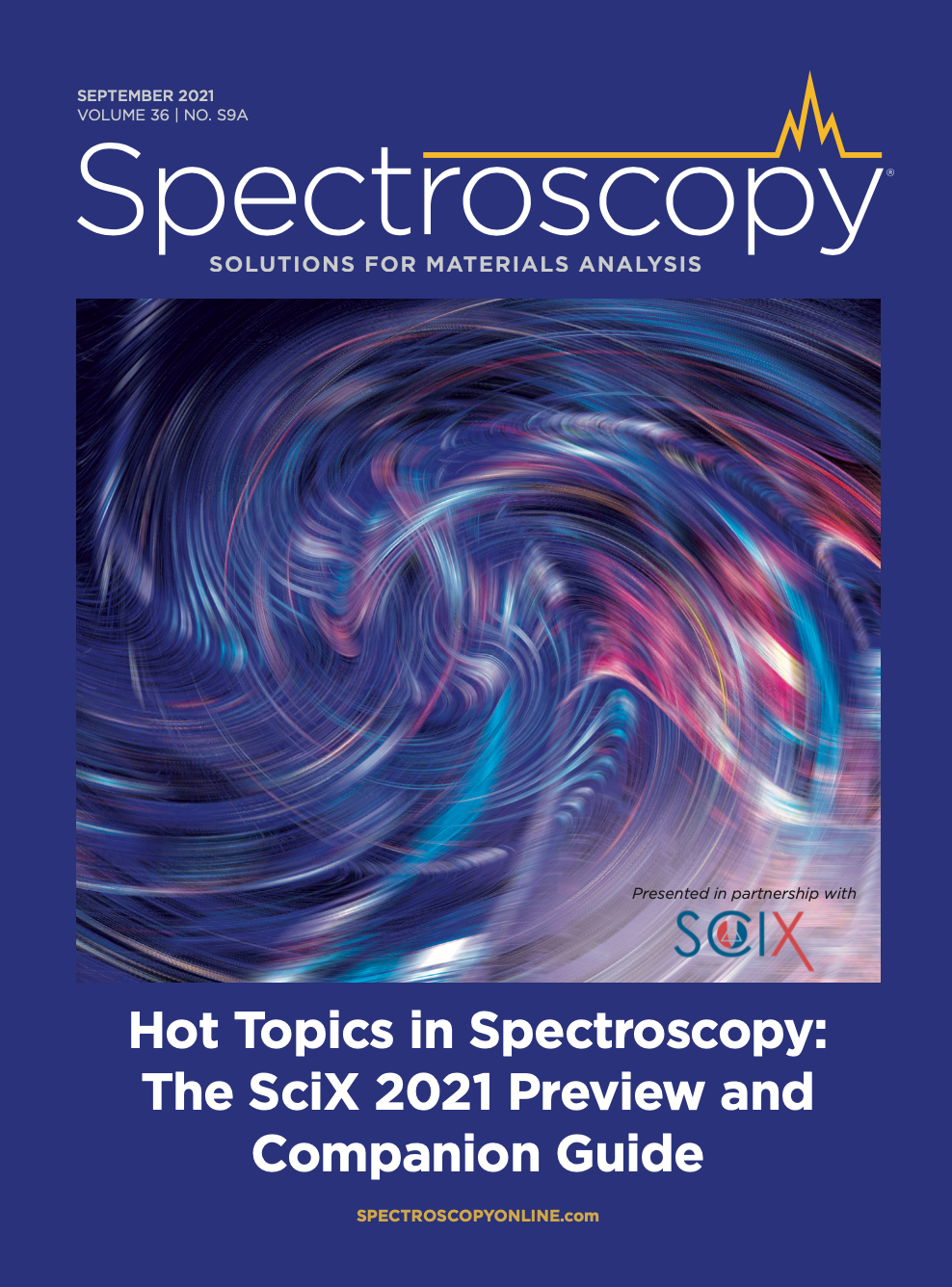Investigating Lanthanide Deposition Patterns in Tissue Using Laser Ablation–Inductively Coupled Plasma–Mass Spectrometry (LA-ICP-MS) Imaging
In recent years, concerns have arisen about the potential accumulation of lanthanides, like lanthanum and gadolinium, in the human body as a result of their use in clinical treatments or imaging contrast agents, or from exposure through drinking water contaminated with contrast agents. Laser ablation–inductively coupled plasma–mass spectrometry (LA-ICP-MS) imaging, which can provide spatially resolved quantification of trace elements in biological samples, is a powerful tool to investigate these questions. Uwe Karst, of the University of Münster in Germany, has been conducting research in this area, and he recently spoke to us about this work. Karst is the 2021 recipient of the Lester W. Strock Award from the New England Chapter of the Society for Applied Spectroscopy (SAS), which will be presented at this year's SciX conference.
In a recent study (1), you investigated the deposition of lanthanum in two patients who received lanthanum carbonate as a phosphate binder due to chronic kidney injury and compared it to additionally found gadolinium deposition resulting from its use as an MRI contrast agent. What are the benefits and risks associated with using these chemicals on human subjects?
This complete research area is based on findings that gadolinium from magnetic resonance imaging (MRI) contrast agents may be deposited in different parts of the human body. This was first found around 2006, when a nephrogenic systemic fibrosis was discovered, caused by deposition of gadolinium in the lower parts of the skin, the dermis. This disease was found to occur only for terminally kidney insufficient patients who received gadolinium-based contrast agents (GBCAs) with linear ligands, while it was not observed for patients who were treated with GBCAs with macrocyclic ligands. In 2015, depositions in the dentate nucleus and other areas of the human brain were found, and, again, they were mainly observed for patients given GBCAs with linear ligands, thus causing significant concern among radiologists. However, despite these discussions, GBCAs remain essential tools for the diagnosis of several diseases, including brain tumors and many others.
Lanthanum carbonate is administered to dialysis patients orally in quantities of up to three grams of lanthanum daily. In the stomach, it is dissolved in the acidic environment, and “free” lanthanum(III) ions are released that may subsequently precipitate and be excreted with phosphate from the patient's blood as lanthanum phosphate. Studies on the total concentration of lanthanum in the human body after significant use of lanthanum carbonate by patients showed only a limited deposition of this element in different organs. For this reason, lanthanum carbonate is considered to be relatively safe for patients compared with other phosphate binders. However, a major reason for its limited use is its comparably high price..
Was the correlation between deposition sites of lanthanum and gadolinium expected or surprising?
At first sight, the co-deposition of both lanthanides is not surprising, considering the chemical similarities of all lanthanides. On the other hand, the chemical binding forms, or species, of both elements, as they enter the human body, differ strongly. For gadolinium, the respective stable complexes are injected intravenously; for lanthanum, a limited quantity of "free" La3+, likely complexed with small endogenous ligands, is taken up, while the majority is excreted as lanthanum phosphate or lanthanum hydroxide.
Lanthanum can therefore be considered as proxy for "free" gadolinium, which might enter the body after oral uptake of contrast agents, such as from contaminated drinking water. It should be considered that the stability of the GBCAs under acidic conditions, including those in our stomach, is limited, giving rise to the expectation that oral uptake of GBCAs would lead to exposure towards “free” lanthanum(III) ions rather than the intact GBCAs. For this reason, our results clearly show that the exposure of humans to the lanthanides strongly depends on the respective binding forms, but that released Gd(III) and La(III) are found in the same areas of the body, as could be expected.
Spatial distribution of gadolinium and lanthanum was determined by quantitative LA-ICP-MS imaging of tissue sections. How many tissue types were sampled, and what are the benefits to using LA-ICP-MS imaging for this analysis over other analytical techniques?
Although we tried to obtain a much larger number of patient samples, one of the challenges of this work was to draw conclusions from the limited number of only two patients. From only one of these patients, we received and investigated several tissues, including cerebellum, thyroid gland, muscle, and liver. LA-ICP-MS imaging was crucial in this work to quantify the concentration of gadolinium and lanthanum in a spatially resolved manner in all of these tissues, thus allowing us to obtain data on the distribution of these and other elements. The paper shows, for example, that the distribution of Gd and La in the vessel walls of the dentate nucleus within the cerebellum is literally identical, but with much larger concentration ratios between Gd and La in this sample than in other organs, thus providing the information that intact GBCAs will have easier access to the brain than “free” lanthanide ions, as in the case of lanthanum carbonate.
LA-ICP-MS is the only easily accessible technique that is able to provide information concerning spatial resolution in the low- to mid-micrometer range and with ppm- to ppb-concentration sensitivity rapidly, and only synchrotron X-ray fluorescence (SXRF) could provide similar information at all, although with strongly limited access to the required large-scale facilities.
What conclusions have you come to so far in your research, both analytically and clinically?
The research of several groups worldwide, including ours, confirms that LA-ICP-MS indeed is a very powerful method for spatially resolved quantification of trace elements in biological samples. The conclusion of this particular work is that oral administration of GBCAs as contamination in drinking water or other sources may result in completely different pathways than intravenous application during medical diagnostics. This is important as people start speculating about human exposure from environmental contamination of GBCAs that may increase in the future, due to increasing medical use of GBCAs.
What special sample preparation techniques are used for this method?
LA-ICP-MS in general only needs limited sample preparation, as samples can be analyzed as thin tissue slices with approximately 3-10 µm thickness, prepared in the same way as pathologists do. Traditionally, pathologists first rinse their samples with increasing amounts of ethanol, followed by increasing amounts of xylene, and finally paraffin embedding. This way, samples can be stored as paraffin blocks at room temperature literally for decades, and the quality of tissue slices for histology even after a long time remains excellent. For LA-ICP-MS, it has to be considered that not only physical sample integrity has to be preserved, as it does for pathology, but that the chemical integrity of the sample has to be preserved as well. Therefore, we always have to consider that no sample constituents should be washed out or carried into the sample to avoid artifacts. Therefore, cryosamples, obtained by rapid freezing of the samples down to -78 °C, often are the method of choice, although cryoartifacts may alter the quality of the tissue slices. In real life, the vast majority of samples will be based on paraffin embedding, and their usefulness depends on the chemical species to be analyzed.
What are the biggest challenges or limitations that you have encountered in developing this method?
In most cases, major challenges are associated with sample preparation in these highly interdisciplinary projects. Earlier work by our group, for example, has shown that intact GBCAs are rapidly washed out from tissues by paraffination and deparaffination procedures, while Gd, which was deposited by dechelation in tissues, may remain there during these processes. Therefore, sample preparation has to be discussed with our cooperation partners from medicine and biology prior to starting any major projects. In this particular case, we were interested in deposited Gd and La, so paraffinated samples were suitable.
What options or alternatives are available to overcome these challenges?
Actually, only a limited number of other options remains. Even if SXRF were available to the required extent, the same challenges would apply, as they are more linked with sample preparation than with the elemental imaging method itself. Over the years, we have learned that it is essential to begin any cooperation with a very clear discussion about what our cooperation partners from medicine and biology can expect with respect to limits of detection, spatial resolution, and information about the analyte. On the other hand, we have to clearly state our requirements regarding sample preparation (paraffin vs. cryosamples) and the consequences that arise, in terms of what analytical information can be obtained, depending on the sample type. As a chemist, I am always excited to see how much more we can achieve in this field by appropriately considering the chemical nature of the analyte and the respective consequences for sampling and calibration.
What are your next steps in this work?
While it will be extremely hard to obtain further samples from patients with a similar history, this study has provided us already with some very important information regarding the differences between intravenous and oral routes of exposure to GBCAs. Therefore, we are currently looking to develop further methods to study the stability of GBCAs under various environmentally relevant conditions and under conditions that GBCAs will be exposed to during their way through the body after oral uptake. First results appear to be promising, and we are very much looking forward to exciting, interdisciplinary future work together with colleagues from medical, biological, and industrial cooperation partners.
Reference
(1) P. Bücker, H. Richter, A. Radbruch, M. Sperling, M. Brand, M. Holling, V. Van Marck, W. Paulus, A. Jeibmann, and U. Karst, J. Trace Elem. Med. Bio. 63, 126665 (2021). https://doi.org/10.1016/j.jtemb.2020.126665
Uwe Karst holds the Chair of Analytical Chemistry at the University of Münster, Germany, since 2005. Previously, he was appointed as Chair of Chemical Analysis at the University of Twente, The Netherlands, from 2001 until 2005. He is author of more than 350 publications in peer-reviewed scientific journals. Uwe ́s research interests cover different aspects of mass spectrometry and hyphenated techniques, ranging from electrochemistry/mass spectrometry for the simulation of the oxidativce metabolism of drugs to metal speciation analysis and elemental as well as molecular mass spectrometric bioimaging.

John Chasse is the Managing Editor of Spectroscopy. Direct correspondence to: jchasse@mjhlifesciences.com ●
